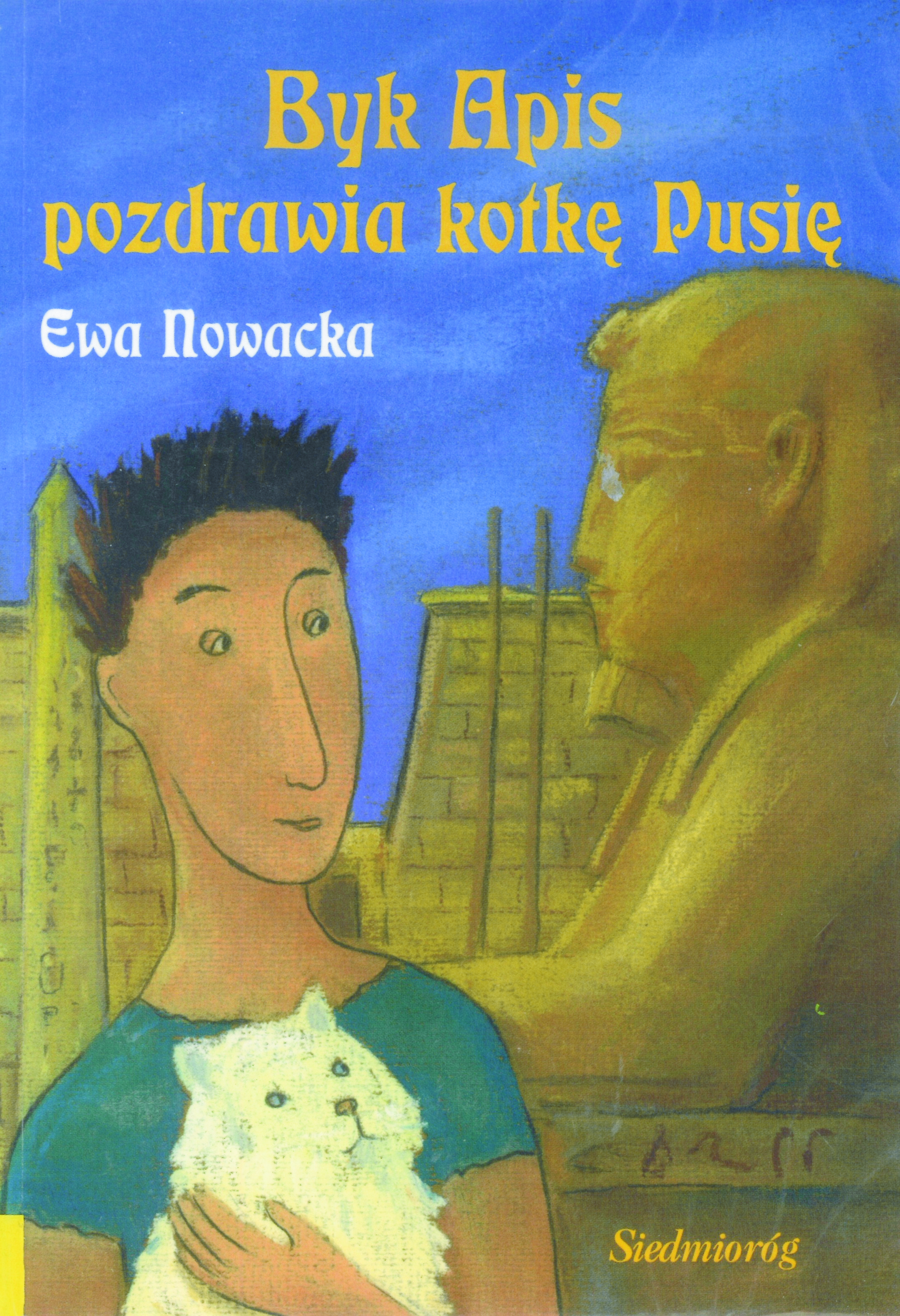Title of the work
Country of the First Edition
Country/countries of popularity
Original Language
First Edition Date
First Edition Details
Ewa Nowacka, Byk Apis pozdrawia kotkę Pusię. Ill. Marzena Zacharewicz, Wrocław: Siedmioróg, 1998, 80 pp.
ISBN
Genre
Time-travel fiction
Target Audience
Crossover (Children, teenagers)
Cover

Courtesy of the publisher.
Author of the Entry:
Summary: Sebastian Mirecki, University of Warsaw, smirecki@student.uw.edu.pl
Analysis: Marta Pszczolińska, University of Warsaw, m.pszczolinska@al.uw.edu.pl
Peer-reviewer of the Entry:
Katarzyna Marciniak, University of Warsaw, kamar@al.uw.edu.pl
Elżbieta Olechowska, University of Warsaw, elzbieta.olechowska@gmail.com

Ewa Nowacka, photograph by Fzsr, retrieved from Wikimedia Commons (accessed: December 29, 2020).
Ewa Nowacka
, 1934 - 2011
(Author)
A novelist, critic and essayist, winner of numerous national and international awards. For lifetime literary achievement she was awarded Janusz Korczak International Literary Prize, medal of the Polish Section of IBBY, the Commander’s Cross of the Order Polonia Restituta, medal of the Commission of National Education, and the Gloria Artis Medal for Merit for Culture (Gold Class). She wrote about 50 books, mostly for children and adolescents. The author of a bestselling novel Małgosia contra Małgosia [Maggy contra Maggy], 1975, about a 17–year–old heroine living in 20th century Warsaw who is suddenly transported into the 17th century. Nowacka felt at home in Pharaoh’s Egypt, Roman Empire and in modern times. For many years she worked at the Polish Radio and produced many radio-plays for children and young adults.
Sources:
lubimyczytac.pl (accessed: December 29, 2020).
pl.wikipedia.org (accessed: December 29, 2020).
Danuta Świerczyńska-Jelonek, "Różne światy powieści Ewy Nowackiej", Guliwer 3 (2004): 5–13.
[Obituary], PAP [Polish Press Agency], Zmarła autorka popularnych książek dla młodzieży, wiadomosci.wp.pl (accessed: December 29, 2020).
Bio prepared by Sebastian Mirecki, University of Warsaw, smirecki@student.uw.edu.pl
Sequels, Prequels and Spin-offs
Ewa Nowacka, Proszę bilet na wieżę Babel, Wrocław: Siedmioróg, 1998.
Ewa Nowacka, Rogi Minotaura, Wrocław: Siedmioróg, 1998.
Ewa Nowacka, Jak okiełznać wronego rumaka, Wrocław: Siedmioróg, 1999.
Summary
Based on: Katarzyna Marciniak, Elżbieta Olechowska, Joanna Kłos, Michał Kucharski (eds.), Polish Literature for Children & Young Adults Inspired by Classical Antiquity: A Catalogue, Faculty of “Artes Liberales”, Warsaw: University of Warsaw, 2013, 444 pp.
This is the first book in the series Skrzydła czasu [The Wings of Time]. Paweł, through an accident with a television game brought by his father, is transported with his cat Pusia to ancient Egypt. Confused and terrified, the boy wants to return as soon as possible to Warsaw to his parents and younger siblings. Unfortunately no one is able to help him. In Egypt, Pusia is treated like a small goddess. Paweł knows the Adventures of Hercules and recalls there were goddesses, Pallas Athena and Hera. He also remembers, that when he was a little child, his mother read him mythical tales by Nathaniel Hawthorne. Finally the bright boy realizes that his cat is considered a sacred animal in Egypt. Unfortunately, Pawi (as the Egyptians call him) offends the children of the Egyptian queen and is condemned to labour on the West Bank of the river; his cat Pusia is taken to the palace. Paweł becomes assistant to a hieroglyphs painter, but is brought back to the palace when Pusia falls seriously ill. He nurses the animal back to health but is still unable to find a way back to his family. In the end, mainly thanks to his cat, a prophetic dream and the sacred bull Apis, he returns home with Pusia.
Analysis
The author uses the motif of time travel to show the child reader the reality of ancient Egypt. The Egyptian part of the storyline is set in the times of queen Hatshepsut of the 18th Dynasty. The boy protagonist sees her as a pharaoh and is surprised by her wearing male garments, a fake beard and regalia indicating her power. The queen is distant and appears only during an official occasion. As for other historical figures – the boy also meets royal children: the queen’s daughter, Princess Neferure and her stepbrother Thutmose III, a future ruler, who behaves exactly like Paweł’s younger siblings – the children get into a fight about who will get the precious cat.
The background created by Nowacka to show Egyptian antiquity mostly includes elements of everyday life: irrigation devices used to increase crops, modest huts, the contrast between a miserable village and a monumental temple decorated with small drawings (which Paweł recognizes as hieroglyphics), the appearance of people (clothes, hairstyles, jewellery) and the treatment they receive (threats, beatings, humiliation, imprisonment or strenuous work), the burial customs, religious rituals or worship of animals.
When the protagonist time travels to ancient Egypt, anytime he does not know or understand something, he tries to make it more familiar by comparing it to something less distant. This is the reason why, when he hears an Egyptian call Pusia goddess, he tries to recall all the information about goddesses he has ever known. He mentions the Adventures of Hercules, where Pallas Athena appears in a helmet and with a spear, as well as Hera, who sends two big snakes to strangle the newborn future slayer of the dreadful Hydra. Paweł does not remember much more about Greek mythology, because his mother read Tanglewood Tales by Nathaniel Hawthorne to him a long time ago, in his early childhood, and he is now ten years old. This mention of Hawthorne as the boy’s source of mythological knowledge shows the phenomenal popularity of the 19th-century American author in Poland, his book was published and reprinted many times*, was present in every public library and widely read by children and to children by their parents.
* Nathaniel Hawthorne, Mity greckie, trans. M. J. Lutosławska, Warszawa : Instytut Wydawniczy "Biblioteka Polska", 1937, 1947, 1948; Warszawa: Nasza Księgarnia, 1960.
Nathaniel Hawthorne, Opowieści z zaczarowanego lasu: mity greckie, trans. Krystyna Tarnowska, Andrzej Konarek, Warszawa: Instytut Wydawniczy „Nasza Księgarnia”, 1973, 1980, 1987, 1988, 1989; Warszawa: Votum, 1992.
Further Reading
Świerczyńska-Jelonek, Danuta, "Różne światy powieści Ewy Nowackiej", Guliwer 3 (2004): 5–13.


